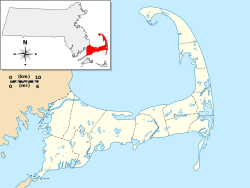Description and history
The Fuller House is set on the northwest side of Parker Road in West Barnstable, just northeast of its junction with Church Street, and is set near the road, behind a low fieldstone wall. Its main block is a 1+1⁄2-story wood-frame structure, three bays wide, with a side-gable roof and wood shingle siding. In a somewhat unusual arrangement for the period, the chimney is located centered behind the northernmost bay, while the main entrance, which is more typically in front of the chimney, is located in the southern bay. The entry is flanked by pilasters and topped by a transom window, typical Federal style features. The windows are six-over-six sash, with simple trim surrounds. There are two small extension ells, one to either side of the main block. The property includes an English barn of approximately the same age just northeast of the house. [2]
Construction of the house is estimated to be about 1800 based on architectural analysis; the house is known to have been standing in 1836. The property was owned at this time by members of the Fuller family, who were engaged in a variety of agricultural pursuits. Parker Road was laid out in 1793 and widened in 1802. [2]
This page is based on this
Wikipedia article Text is available under the
CC BY-SA 4.0 license; additional terms may apply.
Images, videos and audio are available under their respective licenses.




